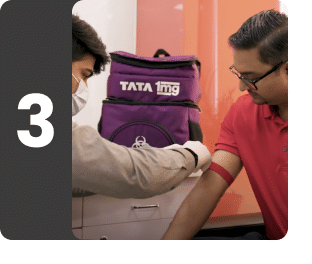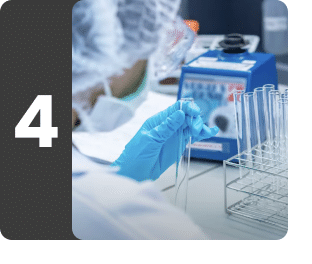Thalassemia Profile in Nashik
Understanding Thalassemia Profile in Nashik
What is Thalassemia Profile in Nashik?
The Thalassemia Profile comprises a group of blood tests that help diagnose and monitor thalassemia, a genetic blood disorder characterized by production of defective hemoglobin. This test helps evaluate parameters like complete blood counts, hemoglobin variants, iron levels, and iron binding capacity in the blood. It is widely available with Tata 1mg labs at an affordable price in Nashik.
Consider getting tested with the Thalassemia Profile if you have a known family history of thalassemia or other hemoglobinopathies; if you have symptoms such as fatigue, weakness, pale skin, etc. which may indicate anemia; if routine blood tests like CBC indicates abnormalities in the red blood cells; as a part of prenatal and newborn screening; and if anemia does not respond to iron supplementation, suggesting a non-iron deficiency cause. This profile also helps differentiate thalassemia from other forms of anemia, monitor treatment response, assess the need for interventions like blood transfusion and identify potential complications like iron overload which can occur due to frequent blood transfusion.
Few special preparations need to be considered before undertaking the Thalassemia Profile. However, these preparations may vary depending on the individual test included in this package.
What does Thalassemia Profile measure?
Contains 25 testsThe Thalassemia Profile includes a range of blood tests namely, hemoglobin high-performance liquid chromatography (Hb HPLC) test which tells about different variants of hemoglobin and helps identify the abnormal variant (e.g, HbS) and its proportion in the blood; complete blood count (CBC) test which provides a holistic view of the blood health. CBC test helps assess the overall health of the blood and identify signs of anemia, which is common in thalassemia. Also, the Thalassemia Profile includes total iron binding capacity (TIBC) test which helps evaluate iron metabolism and can indicate iron deficiency or overload, both of which are significant in the context of thalassemia; serum iron test which helps diagnose and manage thalassemia, as individuals can have varying degree of iron deficiency or excess and unsaturated iron binding capacity (UIBC) test which when complemented with TIBC and serum iron tells about the reserve capacity of blood to bind with iron.
The Thalassemia Profile helps doctors diagnose thalassemia types and monitor its progression over time, tailor appropriate treatment plans such as iron supplementation or blood transfusion to manage the condition and its associated complications.

Hb HPLC (Hb Variants Estimation by HPLC)
An Hb HPLC (Hb Variants Estimation by HPLC) test is used to identify and quantify different types of hemoglobin in the blood to diagnose and monitor specific blood disorders. Different types of hemoglobin are Adult type (HbA2), Fetal type (HbF), Hemoglobin S (HbS), Hemoglobin C (HbC), and Hemoglobin E (HbE), etc.
Normal types of hemoglobin include:
- Hemoglobin (Hgb) A: The most common type of hemoglobin in healthy adults
- Hemoglobin (Hgb) F: Fetal hemoglobin, which is found in unborn babies and newborns. HgbF is replaced by HgbA shortly after birth.
A deranged level of HgbA or HgbF might indicate certain types of anemia.
Abnormal types of hemoglobin include:
- Hemoglobin (Hgb) S: This type of hemoglobin is found in sickle cell anemia, an inherited disorder that causes the body to make stiff, sickle-shaped red blood cells. Sickle cells can get stuck in the blood vessels, causing severe pain, long-term infections, and other complications.
- Hemoglobin (Hgb) C: This type of hemoglobin is associated with hemolytic anemia that develops when your red blood cells are destroyed more easily than normal red blood cells or have a shorter life span than normal red blood cells.
- Hemoglobin (Hgb) E: This type of hemoglobin is mainly found in people of Southeast Asian descent and may be associated with mild anemia or no symptoms.
- Hemoglobin (Hgb) D: Hb D disease (HbDD) is characterized by mild hemolytic anemia and mild to moderate splenomegaly. Hb D Punjab occurs with the most significant prevalence in Gujarat and Sikhs of Punjab.
Know more about Hb HPLC (Hb Variants Estimation by HPLC)

CBC (Complete Blood Count)
The CBC (Complete Blood Count) test evaluates red blood cells (RBCs), white blood cells (WBCs}, and platelets. Each of these blood cells performs essential functions–RBCs carry oxygen from your lungs to the various body parts, WBCs help fight infections and other diseases, and platelets help your blood to clot–so determining their levels can provide significant health information. A CBC test also determines the hemoglobin level, a protein in RBC that carries oxygen from the lungs to the rest of your body. Evaluating all these components together can provide important information about your overall health.
Know more about CBC (Complete Blood Count)
Differential Leukocyte Count
- Differential Neutrophil Count
- Differential Lymphocyte Count
- Differential Monocyte Count
- Differential Eosinophil Count
- Differential Basophil Count
There are five types of WBCs: neutrophils, lymphocytes, monocytes, eosinophils, and basophils. A Differential Leukocyte Count test measures the percentage of each type of WBC in the blood. Leukocytes or WBCs are produced in the bone marrow and defend the body against infections and diseases. Each type of WBC plays a unique role to protect against infections and is present in different numbers.
This further contains
Red Blood Cell Count
The Red Blood Cell Count test measures the total number of red blood cells in your blood. RBCs are the most abundant cells in the blood with an average lifespan of 120 days. These cells are produced in the bone marrow and destroyed in the spleen or liver. Their primary function is to help carry oxygen from the lungs to different body parts. The normal range of RBC count can vary depending on age, gender, and the equipment and methods used for testing.
Hb (Hemoglobin)
An Hb (Hemoglobin) test measures the concentration of hemoglobin protein in your blood. Hemoglobin is made up of iron and globulin proteins. It is an essential part of RBCs and is critical for oxygen transfer from the lungs to all body tissues. Most blood cells, including RBCs, are produced regularly in your bone marrow. The Hb test is a fundamental part of a complete blood count (CBC) and is used to monitor blood health, diagnose various blood disorders, and assess your response to treatments if needed.
Platelet Count
The Platelet Count test measures the average number of platelets in the blood. Platelets are disk-shaped tiny cells originating from large cells known as megakaryocytes, which are found in the bone marrow. After the platelets are formed, they are released into the blood circulation. Their average life span is 7-10 days.
Platelets help stop the bleeding, whenever there is an injury or trauma to a tissue or blood vessel, by adhering and accumulating at the injury site and releasing chemical compounds that stimulate the gathering of more platelets. A loose platelet plug is formed at the site of injury and this process is known as primary hemostasis. These activated platelets support the coagulation pathway that involves a series of steps, including the sequential activation of clotting factors; this process is known as secondary hemostasis. After this step, there is a formation of fibrin strands that form a mesh incorporated into and around the platelet plug. This mesh strengthens and stabilizes the blood clot so that it remains in place until the injury heals. After healing, other factors come into play and break the clot down so that it gets removed. In case the platelets are not sufficient in number or not functioning properly, a stable clot might not form. These unstable clots can result in an increased risk of excessive bleeding.
Total Leukocyte Count
The Total Leukocyte Count test measures the numbers of all types of leukocytes, namely neutrophil, lymphocyte, monocyte, eosinophil, and basophil, in your blood. Leukocytes or WBCs are an essential part of our immune system. These cells are produced in the bone marrow and defend the body against infections and diseases. Each type of WBC plays a unique role to protect against infections and is present in different numbers.
Hematocrit
The Hematocrit test measures the proportion of red blood cells (RBCs) in your blood as a percentage of the total blood volume. It is a crucial part of a complete blood count (CBC) and helps in assessing your blood health. RBCs are responsible for carrying oxygen from the lungs to different parts of the body. The hematocrit test provides valuable information about your blood's oxygen-carrying capacity.
Higher-than-normal amounts of RBCs produced by the bone marrow can cause the hematocrit to increase, leading to increased blood density and slow blood flow. On the other hand, lower-than-normal hematocrit can be caused by low production of RBCs, reduced lifespan of RBCs in circulation, or excessive bleeding, leading to a reduced amount of oxygen being transported by RBCs. Monitoring your hematocrit levels is essential for diagnosing and managing various blood-related disorders.
Mean Corpuscular Volume
The Mean Corpuscular Volume test measures the average size of your red blood cells, which carry oxygen through your body. This test tells whether your RBCs are of average size and volume or whether they are bigger or smaller.
Mean Corpuscular Hemoglobin
An MCH test measures the average amount of hemoglobin in a single red blood cell (RBC). Hemoglobin is an iron-containing protein in RBCs, and its major function is to transport oxygen from the lungs to all body parts. This test provides information about how much oxygen is being delivered to the body by a certain number of RBCs.
Mean Corpuscular Hemoglobin Concentration
An MCHC test measures the average amount of hemoglobin in a given volume of RBCs. MCHC is calculated by dividing the amount of hemoglobin by hematocrit (volume of blood made up of RBCs) and then multiplying it by 100.
Mean Platelet Volume
An MPV test measures the average size of the platelets in your blood. Platelets are disk-shaped tiny cells originating from large cells known as megakaryocytes, which are found in the bone marrow. After the platelets are formed, they are released into the blood circulation. Their average life span is 7-10 days.
Platelets help stop bleeding whenever there is an injury or trauma to a tissue or blood vessel by adhering and accumulating at the injury site, and by releasing chemical compounds that stimulate the gathering of more platelets. After these steps, a loose platelet plug is formed at the site of injury, and this process is known as primary hemostasis. These activated platelets support the coagulation pathway that involves a series of steps including the sequential activation of clotting factors; this process is known as secondary hemostasis. After this, there is a formation of fibrin strands that form a mesh incorporated into and around the platelet plug. This mesh strengthens and stabilizes the blood clot so that it remains in place until the injury heals. After healing, other factors come into play and break the clot down so that it gets removed. In case the platelets are not sufficient in number or are not functioning properly, a stable clot might not form. These unstable clots can result in an increased risk of excessive bleeding.
PDW
The PDW test reflects variability in platelet size, and is considered a marker of platelet function and activation (clot formation in case of an injury). This marker can give you additional information about your platelets and the cause of a high or low platelet count. Larger platelets are usually younger platelets that have been recently released from the bone marrow, while smaller platelets may be older and have been in circulation for a few days. Higher PDW values reflect a larger range of platelet size, which may result from increased activation, destruction and consumption of platelets.
RDW CV
The RDW CV test which is part of red cell indices, helps identify characteristics of red blood cells. RDW (red cell distribution width) measures the variations in the sizes of red blood cells, indicating how much they differ from each other in a blood sample. RDW is expressed as RDW-CV, a coefficient of variation. A higher RDW may suggest more variation in red cell sizes, while a lower RDW indicates more uniform red cell sizes.
Absolute Leucocyte Count
- Absolute Lymphocyte Count
- Absolute Neutrophil Count
- Absolute Basophil Count
- Absolute Monocyte Count
- Absolute Eosinophil Count
The Absolute Leucocyte Count test measures the total number of white blood cells (leucocytes) in the given volume of blood. It examines different types of white blood cells such as neutrophils, lymphocytes, monocytes, basophils and eosinophils. These cells tell about the status of the immune system and its ability to fight off infections and other conditions like inflammation, allergies, bone marrow disorders etc.
This further contains

Total Iron Binding Capacity
The Total Iron Binding Capacity test measures the ability of your blood to bind and transport iron, and therefore reflects your body's iron stores. TIBC correlates with the amount of transferrin, a protein, in your blood, that helps bind iron and facilitates its transportation in the blood. Usually, about one-third of the transferrin measured is being used to transport iron, and this is called transferrin saturation.
Know more about Total Iron Binding Capacity

Iron, Serum
An Iron, Serum test determines iron levels in the blood and can help diagnose conditions like anemia, or iron overload in the body. People usually suffer from low iron levels in the blood if they prefer a diet that has low iron content, or if their body has trouble absorbing the iron from the foods or supplements they intake. Low iron levels can also occur due to intense blood loss or even during pregnancy. Similarly, an excess amount of iron in the blood can occur due to over-intake of iron supplements, blood transfusions, or if you are suffering from a condition called hemochromatosis (a rare genetic disorder that causes too much iron to build up in the body or cause problems in the body to remove excess iron).
Therefore, doctors often suggest an Iron, Serum to help check the status of your iron level, get valuable information about your nutritional well-being, detect potential health issues (if any), and take timely preventive measures.
Know more about Iron, Serum

Unsaturated Iron Binding Capacity
An Unsaturated Iron Binding Capacity test determines the reserve capacity of transferrin, i.e., the portion not yet saturated with iron. The iron-binding capacity of our body can be segregated into two parts – Total Iron Binding Capacity (TIBC) and Unsaturated Iron Binding Capacity (UIBC). UIBC refers to the capacity of transferrin, a protein that transports iron, to bind with additional iron. In easy terms, it represents the available "slots" on transferrin to carry iron molecules. Unlike iron saturation, which assesses the occupied slots, UIBC measures the unoccupied ones.
Know more about Unsaturated Iron Binding Capacity
Answers to Patient Concerns & Frequently Asked Questions (FAQs) about Thalassemia Profile in Nashik
Frequently Asked Questions about Thalassemia Profile in Nashik
Q. What is the Thalassemia Profile?
Q. What blood tests indicate thalassemia?
Q. Why often should I get the Thalassemia Profile?
Q. What are the risks associated with the Thalassemia Profile?
Q. Can I schedule the Thalassemia Profile online in Nashik near me?
Q. Is home sample collection facility available for the Thalassemia Profile in Nashik with Tata 1mg Labs?
Q. How can I schedule the Thalassemia Profile with Tata 1mg Labs in Nashik?
Q. What is the cost of the Thalassemia Profile at Tata 1mg Labs in Nashik?
Q. How long does Tata 1mg Labs take to give the reports of the Thalassemia Profile in Nashik?
Book Thalassemia Profile at-home





Other tests









